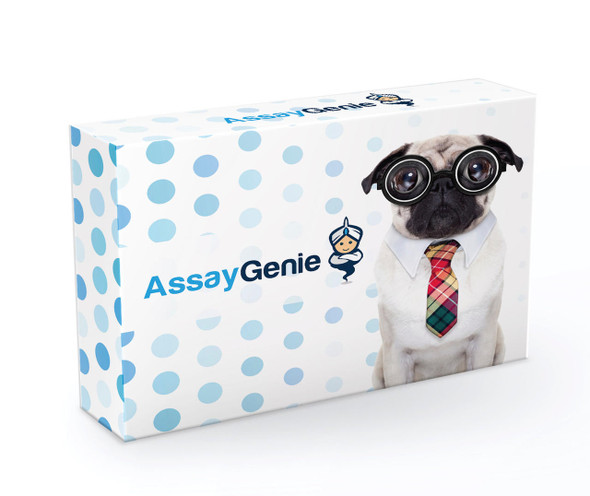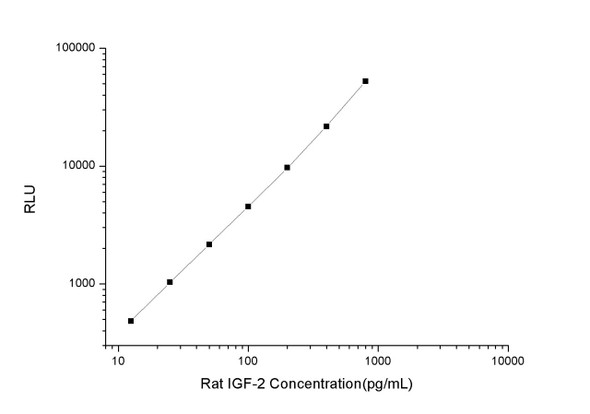Rat Signaling ELISA Kits 2
Rat IGF-1 (Insulin-Like Growth Factor 1) CLIA Kit (RTES00010)
- SKU:
- RTES00010
- Product Type:
- ELISA Kit
- ELISA Type:
- CLIA Kit
- Size:
- 96 Assays
- Sensitivity:
- 7.5pg/mL
- Range:
- 12.5-800pg/mL
- ELISA Type:
- Sandwich
- Synonyms:
- IGF1, IGFI, IGF-I, IGF1A, IGF-IA, IGF-IB, MGF, Somatomedin C
- Reactivity:
- Rat
- Sample Type:
- Serum, plasma and other biological fluids
Description
| Assay type: | Sandwich |
| Format: | 96T |
| Assay time: | 4.5h |
| Reactivity: | Rat |
| Detection method: | Chemiluminescence |
| Detection range: | 12.50-800 pg/mL |
| Sensitivity: | 7.50 pg/mL |
| Sample volume: | 100µL |
| Sample type: | Serum, plasma and other biological fluids |
| Repeatability: | CV < 15% |
| Specificity: | This kit recognizes Rat IGF-1 in samples. No significant cross-reactivity or interference between Rat IGF-1 and analogues was observed. |
This kit uses Sandwich-CLIA as the method. The micro CLIA plate provided in this kit has been pre-coated with an antibody specific to Rat IGF-1. Standards or samples are added to the appropriate micro CLIA plate wells and combined with the specific antibody. Then a biotinylated detection antibody specific for Rat IGF-1 and Avidin-Horseradish Peroxidase (HRP) conjugate are added to each micro plate well successively and incubated. Free components are washed away. The substrate solution is added to each well. Only those wells that contain Rat IGF-1, biotinylated detection antibody and Avidin-HRP conjugate will appear fluorescence. The Relative light unit (RLU) value is measured spectrophotometrically by the Chemiluminescence immunoassay analyzer. The RLU value is positively associated with the concentration of Rat IGF-1. The concentration of Rat IGF-1 in the samples can be calculated by comparing the RLU of the samples to the standard curve.
| UniProt Protein Function: | The insulin-like growth factors, isolated from plasma, are structurally and functionally related to insulin but have a much higher growth-promoting activity. May be a physiological regulator of [1-14C]-2-deoxy-D-glucose (2DG) transport and glycogen synthesis in osteoblasts. Stimulates glucose transport in bone-derived osteoblastic (PyMS) cells and is effective at much lower concentrations than insulin, not only regarding glycogen and DNA synthesis but also with regard to enhancing glucose uptake. May play a role in synapse maturation. Ca2+-dependent exocytosis of IGF1 is required for sensory perception of smell in the olfactory bulb. Acts as a ligand for IGF1R. Binds to the alpha subunit of IGF1R, leading to the activation of the intrinsic tyrosine kinase activity which autophosphorylates tyrosine residues in the beta subunit thus initiatiating a cascade of down-stream signaling events leading to activation of the PI3K-AKT/PKB and the Ras-MAPK pathways. Binds to integrins ITGAV:ITGB3 and ITGA6:ITGB4. Its binding to integrins and subsequent ternary complex formation with integrins and IGFR1 are essential for IGF1 signaling. Induces the phosphorylation and activation of IGFR1, MAPK3/ERK1, MAPK1/ERK2 and AKT1. |
| NCBI Summary: | growth factor; plays a major role in mammalian growth [RGD, Feb 2006] |
| UniProt Code: | P08025 |
| NCBI GenInfo Identifier: | 124262 |
| NCBI Gene ID: | 24482 |
| NCBI Accession: | P08025. 3 |
| UniProt Secondary Accession: | P08025,P08024, |
| UniProt Related Accession: | P08025 |
| Molecular Weight: | 17,831 Da |
| NCBI Full Name: | Insulin-like growth factor I |
| NCBI Synonym Full Names: | insulin-like growth factor 1 |
| NCBI Official Symbol: | Igf1 |
| NCBI Protein Information: | insulin-like growth factor I; IGF-I; somatomedin |
| UniProt Protein Name: | Insulin-like growth factor I |
| UniProt Synonym Protein Names: | Somatomedin |
| Protein Family: | Insulin-like growth factor |
| UniProt Gene Name: | Igf1 |
| UniProt Entry Name: | IGF1_RAT |
As the RLU values of the standard curve may vary according to the conditions of the actual assay performance (e. g. operator, pipetting technique, washing technique or temperature effects), the operator should establish a standard curve for each test. Typical standard curve and data is provided below for reference only.
| Concentration (pg/mL) | RLU | Average | Corrected |
| 800 | 48315 56969 | 52642 | 52616 |
| 400 | 19758 23710 | 21734 | 21708 |
| 200 | 10072 9344 | 9708 | 9682 |
| 100 | 4545 4559 | 4552 | 4526 |
| 50 | 2193 2183 | 2188 | 2162 |
| 25 | 1075 1045 | 1060 | 1034 |
| 12.50 | 488 530 | 509 | 483 |
| 0 | 26 26 | 26 | -- |
Precision
Intra-assay Precision (Precision within an assay): 3 samples with low, mid range and high level Rat IGF-1 were tested 20 times on one plate, respectively.
Inter-assay Precision (Precision between assays): 3 samples with low, mid range and high level Rat IGF-1 were tested on 3 different plates, 20 replicates in each plate.
| Intra-assay Precision | Inter-assay Precision | |||||
| Sample | 1 | 2 | 3 | 1 | 2 | 3 |
| n | 20 | 20 | 20 | 20 | 20 | 20 |
| Mean (pg/mL) | 39.76 | 95.95 | 349.43 | 42.96 | 98.56 | 338.71 |
| Standard deviation | 3.84 | 11.03 | 36.79 | 3.81 | 7.27 | 23.91 |
| C V (%) | 9.66 | 11.50 | 10.53 | 8.87 | 7.38 | 7.06 |
Recovery
The recovery of Rat IGF-1 spiked at three different levels in samples throughout the range of the assay was evaluated in various matrices.
| Sample Type | Range (%) | Average Recovery (%) |
| Serum (n=5) | 89-102 | 94 |
| EDTA plasma (n=5) | 93-107 | 99 |
| Cell culture media (n=5) | 97-109 | 104 |
Linearity
Samples were spiked with high concentrations of Rat IGF-1 and diluted with Reference Standard & Sample Diluent to produce samples with values within the range of the assay.
| Serum (n=5) | EDTA plasma (n=5) | Cell culture media (n=5) | ||
| 1:2 | Range (%) | 95-109 | 90-105 | 91-103 |
| Average (%) | 101 | 97 | 96 | |
| 1:4 | Range (%) | 86-97 | 92-104 | 93-106 |
| Average (%) | 91 | 97 | 100 | |
| 1:8 | Range (%) | 86-100 | 91-103 | 97-110 |
| Average (%) | 91 | 97 | 103 | |
| 1:16 | Range (%) | 85-98 | 100-118 | 102-119 |
| Average (%) | 91 | 108 | 108 |
An unopened kit can be stored at 4°C for 1 month. If the kit is not used within 1 month, store the items separately according to the following conditions once the kit is received.
| Item | Specifications | Storage |
| Micro CLIA Plate(Dismountable) | 8 wells ×12 strips | -20°C, 6 months |
| Reference Standard | 2 vials | |
| Concentrated Biotinylated Detection Ab (100×) | 1 vial, 120 µL | |
| Concentrated HRP Conjugate (100×) | 1 vial, 120 µL | -20°C(shading light), 6 months |
| Reference Standard & Sample Diluent | 1 vial, 20 mL | 4°C, 6 months |
| Biotinylated Detection Ab Diluent | 1 vial, 14 mL | |
| HRP Conjugate Diluent | 1 vial, 14 mL | |
| Concentrated Wash Buffer (25×) | 1 vial, 30 mL | |
| Substrate Reagent A | 1 vial, 5 mL | 4°C (shading light) |
| Substrate Reagent B | 1 vial, 5 mL | 4°C (shading light) |
| Plate Sealer | 5 pieces | |
| Product Description | 1 copy | |
| Certificate of Analysis | 1 copy |
- Set standard, test sample and control (zero) wells on the pre-coated plate and record theirpositions. It is recommended to measure each standard and sample in duplicate. Note: addall solutions to the bottom of the plate wells while avoiding contact with the well walls. Ensuresolutions do not foam when adding to the wells.
- Aliquot 100µl of standard solutions into the standard wells.
- Add 100µl of Sample / Standard dilution buffer into the control (zero) well.
- Add 100µl of properly diluted sample (serum, plasma, tissue homogenates and otherbiological fluids. ) into test sample wells.
- Cover the plate with the sealer provided in the kit and incubate for 90 min at 37°C.
- Aspirate the liquid from each well, do not wash. Immediately add 100µL of BiotinylatedDetection Ab working solution to each well. Cover the plate with a plate seal and gently mix. Incubate for 1 hour at 37°C.
- Aspirate or decant the solution from the plate and add 350µL of wash buffer to each welland incubate for 1-2 minutes at room temperature. Aspirate the solution from each well andclap the plate on absorbent filter paper to dry. Repeat this process 3 times. Note: a microplatewasher can be used in this step and other wash steps.
- Add 100µL of HRP Conjugate working solution to each well. Cover with a plate seal andincubate for 30 min at 37°C.
- Aspirate or decant the solution from each well. Repeat the wash process for five times asconducted in step 7.
- Add 100µL of Substrate mixture solution to each well. Cover with a new plate seal andincubate for no more than 5 min at 37°C. Protect the plate from light.
- Determine the RLU value of each well immediately.






